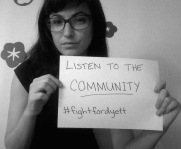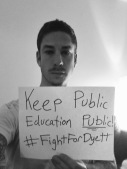In a multi part series I will review the history of caucuses in the UFT from my perspective over the past 45 years. I will point to a history of divisions and fragmentation - I certainly played a role - I believe has served to undermine the growth of an effective counter to Unity and how MORE emerged as an alternative so-called "big umbrella" caucus in an effort too merge a variety of groups and interests.
Since my first involvement in UFT internal issues in 1970, my 4th year of teaching, I can remember very few elections - if any - where one opposition caucus went straight up against Unity Caucus. Most of the time there were either 3 caucuses running or caucuses that united for the elections only.
Over most of this time I never felt it particularly crucial to try to unite all opposition voices under one banner because it seemed so difficult to blend a wide variety of voices and politics and it just didn't seem worth the pain and trouble and angst. I had the philosophy of "let each caucus do its thing and organize the people it was capable of organizing."
I felt that way until soon after the 2010 UFT election - with the outcome for the ICT/TJC slate which is what led many of us to MORE which is just such an "umbrella" attempt - with all the ensuing pain and trouble and angst. So how did I get from there to here? Because all other models over the 40 years I was active seemed to end up going nowhere.
I became active in 1970 in a local group of activist teachers in District 14 (Williamsburg/Greenpoint and a slice of northern Bed-Stuy) called Another View. We weren't a caucus - we had no intention of running in a UFT election - we were advocates and provided analysis of a wide range of issues on education and beyond in addition to the local District 14. Our monthly newsletters were aimed at reaching into as many schools in the district as we could get it into -- while facing enormous hostility from a district UFT political machine allied with the people running the district on the local school board - almost all white in a 95% school population of kids of color. Our people often faced threats and harassment for daring to support us.
Then we met a similar group in District 16 and individuals from other districts and high schools around the city and a sort of nascent coalition was born that began to act as a caucus of sorts.
The major caucus that challenged Unity at the time was
Teachers Action Caucus - TAC. They had a wide range of people in the schools united by their opposition to the UFT's 1968 strike. Many of them crossed the picket lines and TAC was branded by Unity as the "scabs". In addition, there was a strong influence in TAC of the by then pretty moribund Communist Party - Unity also branded them as such. Many of their leaders were older - the old Left. They were very damaged by the Red Scares and some of their former leaders had been fired in the purges of teachers in the 50s when they were part of the old TU - Teachers Union - which had existed since the 1920s before going defunct in 1964 not long after losing the collective bargaining election to what became Unity Caucus.
At some point - around 1973 - we joined TAC en masse, hoping to move them in more progressive "new left" position, with attention to issues we were concerned with that they did not seem to want to deal with. We met a stone wall and after a year we left en masse to form the Coalition of School Workers - not a caucus in the sense of running in UFT elections but continuing to work at the UFT delegate assembly and other venues of the union - central and local.
Then after the 1975 strike* [see below for elaboration] when we began to gain supporters for our strong stand against what we saw as a Unity sell-out, we began to suffer our own internal problems and a group split off from us to form a new caucus called
New Directions - led by an often effective but also a very controversial leader named Marc Pessin who eventually dominated the caucus, especially after purging the leftists - who formed yet another group called Chalk Dust. (He used tactics such as changing the location of a meeting without telling people who resisted him.)* [See a profile of Marc in Part II].
Oy!
So that was the scene as we hit the latter part of the 70s. Our group - CSW - eventually reached out to TAC to form an alliance for the 1977 UFT elections and even tried to get New Direction to join in -- but their megalomaniac leader would have not of that - wanting to assure he would get to run against Shanker. Our slate and ND pretty much split the opposition vote - about 25-30% of the total.
And thus was born multiple oppositions - a
CSW/TAC and a
New Directions slate - a bad message to even anti-Unity people who would ask "Why can't you guys all get together in one caucus and if you can't even do that why should we vote to put you in power, no matter how bad Unity is?" While our group still did not find it easy to work with TAC we bit the bullet.
By 1981 - one thing was clear - at the very least, the 3 groups should get together for UFT elections - and thus was born NAC - New Action Coalition - not a merger of groups but a temporary cooperative for UFT elections - TAC, ND and CSW - and then they would go their own way.
Of course there was a wrinkle even then - the controversial leader of New Directions declared he had to be the presidential candidate and even though just about everyone outside of New Directions had some disdain, if not outright dislike for that individual, his holding everyone hostage - threatening that he would run ND separately if we did not make him the candidate - people held their noses - knowing we would not win - and formed a united slate - and still won nothing.
It was not until 1985 - by that time my own group - CSW - had morphed into a tight friendship group that was not as much involved - that NAC won anything - the high school Vice Presidency - which Unity promptly challenged and tied up in court for almost half the term of office. The NAC coalition continued to run - in the late 80s New Directions had dumped the controversial leader - and let me say here - one of the truly great organizers I have met - (He had a 2nd act a decade later -which will come in Part II).
With some people from Chalk Dust joining the election coalition in 1991 - NAC had its biggest success ever - winning 13 seats on the Exec Bd - the high school and junior high schools. But imagine this -- they all came from the different groups -- TAC, ND, Chalk Dust (the CSW didn't partake) and working together was not something they did easily. In fact, some people tell me the very issue of running in the elections created divisions in Chalk Dust and they ceased to exist soon after.
NAC won nothing in the 1993 elections but almost did win the middle school and high school vice presidential positions, which would have given NAC 2 out of 11 positions on the AdCom. Unity, in a state of panic after dodging that bullet immediately moved to change the constitution in 1994 to make this impossible in the future by removing the elem, ms, and hs divisional VP positions from being voted on in the divisions and making them at-large. Thus for the 1995 elections, middle, high and elementary school teachers no longer were the sole voters for their VP - everyone in the union got to vote, including retirees.
In 1995, NAC still existed with 2 main groups - the still somewhat leftish TAC - even though they did not raise many left wing positions - and New Directions - more center with some rightist elements. My memory is fading but I believe NAC may have won the 6 high school Exec Board seats in that election.
By that time it began to make sense for both TAC and ND to end the farce and merge into one group. And so they did in 1995/6 just in time to help lead the massive turn down of the first version of the 1995 contract negotiated by a relative newbie in the UFT named Randi Weingarten.*[see below for elaboration].
For the first time in over a generation, there was one caucus only in the UFT going head to head with Unity -- but that didn't last very long.
End Part I
Part II (1995-2001/2) will include the founding of Education Notes with support of the old CSW people, the rise of a new caucus, Progressive Action Caucus, the role of yet another caucus - Teachers for a Just Contract (founded in 1993 by remnants of Chalk Dust).
Part III 2002-2012): ( the New Action sellout to Randi in 2002/4, the consequent rise of ICE (Ed Notes, CSW, New Action defectors and others) along with the move of TJC to run in the 2004 elections for the first time, GEM, NYCORE, Teachers Unite, formation of MORE.
Part 1V (2012-present): The trials and tribulations of MORE.
Supplemental
Response to comments on original publication:
nonymousFriday, September 4, 2015 at 1:48:00 AM EDT















